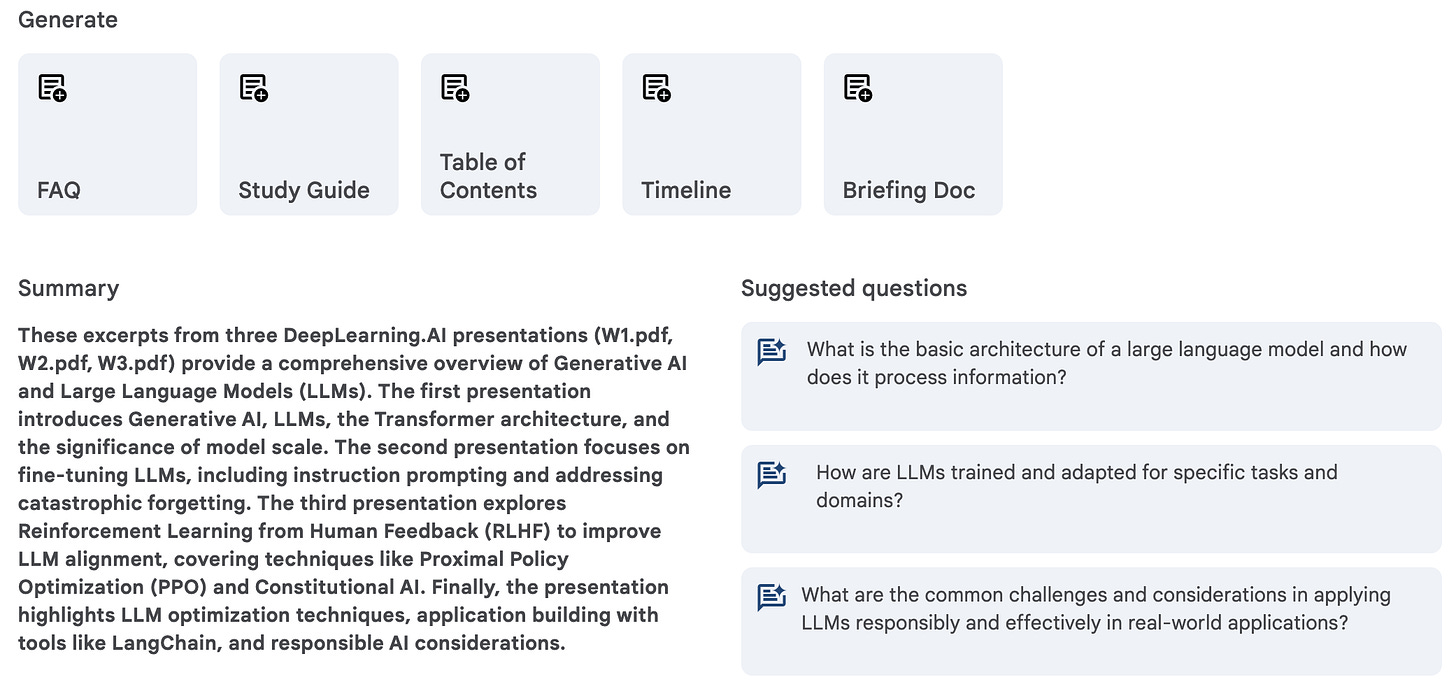How Google's Powerful AI Notebook Will Transform Your Research And Learning
Double your learning speed with a revolutionary note-taking system
Note-taking should boost productivity, not bury you in chaos. Organizing notes scattered across 20 local folders and 10 Google Drives folders? That's a nightmare.
Saving insightful articles should enrich your knowledge, not gather digital dust. How often do you save brilliant articles only to forget them? 🙋♀️
Researching with Gen AI should enlighten, not confuse. Struggling with disorganized information and AI hallucinations defeats the purpose.
Imagine a world where your notes, articles, and research seamlessly integrate. This AI Notebook turns that vision into reality. ⬇️
Say goodbye to boring notebooks and hello to NotebookML 📒

What is NotebookML?
A revolutionary note-organizing AI tool by Google Labs. Powered by Gemini, it’s your personal Large Language Model, trained on your private library.
It’s a game-changer for anyone who deals with large volumes of information.
Features and functionalities
Notebooks: Create dedicated spaces for individual topics. For example, I have notebooks titled “How LLM Works and Applications” and “Writing.”
Sources: Feed your AI with diverse inputs: Google Drive, PDFs, text files, copied text, web page URLs, and Markdown files.
Notes: NotebookML stores all outputs neatly.
Why does NotebookML enhance research and learning?
Inline citations: Every answer includes inline citations, showing the exact source used by the AI.
Domain specific: Instructs the AI to pull from your uploaded sources, making it your personal library.
Personal tutor: Creates quizzes to enhance your learning, which we’ll dive into in section 3.
Data security and privacy: Ensures your data remains private and isn’t used to train the AI, unless you choose to share it.
Minimizes hallucination: Reduces the risk of inaccurate results by focusing on your selected sources.
Use case 1: Smart writing assistant
Step 1: Upload sources
I created a notebook titled "Writing" and uploaded six sources. Two were my notes, and four were online articles about effective writing from
and Ayodeji Awosika.Step 2: Review the summary
NotebookML generated a summary, suggested five ways to expand content (FAQ, study guide, table of contents, timeline, and briefing doc), and proposed three questions based on the sources.
Pretty neat!
Step 3: Issue commands
I wanted to write an article on "essential skills to land data science interviews," so I asked NotebookML for title suggestions. In Step 1, I uploaded a source called "headline vault," containing 50 title formulas for the AI to reference. Here’s what it came up with:
The results all drew from my headline vault!
Furthermore, I can ask the AI to help me write using advice exclusively from Cole and Awosika, rather than relying on generic pre-trained writing tips.
Use case 2: Knowledgeable personal tutor
I recently enrolled in a Coursera course on how LLM works and how to build applications. To deepen my understanding, I decided to gather all the notes provided by the course in NotebookML and let it create a quiz for me.
Step 1: Upload sources
I created a notebook titled “How LLM Works and Applications” and uploaded all my course notes as sources.
Step 2: Review the summary
At first glance, I felt thrilled with the summary and suggested questions. They perfectly encapsulated the 3-week course material.
NotebookML’s ability to extract and interpret non-linear information from a PDF blew me away. For instance, it understood the diagrams embedded in my course notes.

Step 3: Generate a quiz
I clicked the “Study Guide” box on the top left, waited a moment, and—BOOM!
The quality of the questions and answers impressed me. NotebookML even created essay questions and a glossary of key terms.
Step 4: Dive deeper
Curious about Reinforcement Learning, I asked for more information.
NotebookML suggested three papers, all grounded in the sources I uploaded, and cited them accurately.
The AI doesn't just organize your notes—it actively enhances your understanding, making study sessions more productive and engaging.
Limitations to consider
While NotebookML is powerful, it’s not perfect.
You can only add up to 50 sources per notebook. Although combining multiple sources into a single document can work around this, it can become cumbersome with a large number of sources.
It doesn't integrate with other note-taking apps like Notion or Evernote.
Newly added resources require manual re-running of notes, as automatic updates are not yet available.
The tool is unable to display images and mathematical equations, which might limit its usefulness.
Lastly, it can still produce inaccuracies. Avoid relying on it for critical medical, legal, financial, or other professional advice.
The future of academia with RAG 🔮
Imagine having a personal assistant who not only answers your questions but also reads all the latest research and finds exactly what you need. That’s what Retrieval-augmented generation (RAG) does for large language models. RAG makes these models smarter by feeding them custom data, helping them tackle specific tasks with pinpoint accuracy.
Think of NotebookLM as the perfect example of RAG in action.
RAG shines in chatbots and Q&A systems that need real-time updates or specialized knowledge. Picture a chatbot that doesn’t just give you any answer but dives into the newest research or specific databases to find the best information.
I can see a wave of RAG-powered tools like NotebookLM transforming academia. These applications will arm researchers, educators, and students with the ability to access and use knowledge more efficiently than ever before.













This tool sounds great and your review is nicely balanced, so feels more legitimate.
I was a bit on the fence until you mentioned that you can keep your notes private from the training model